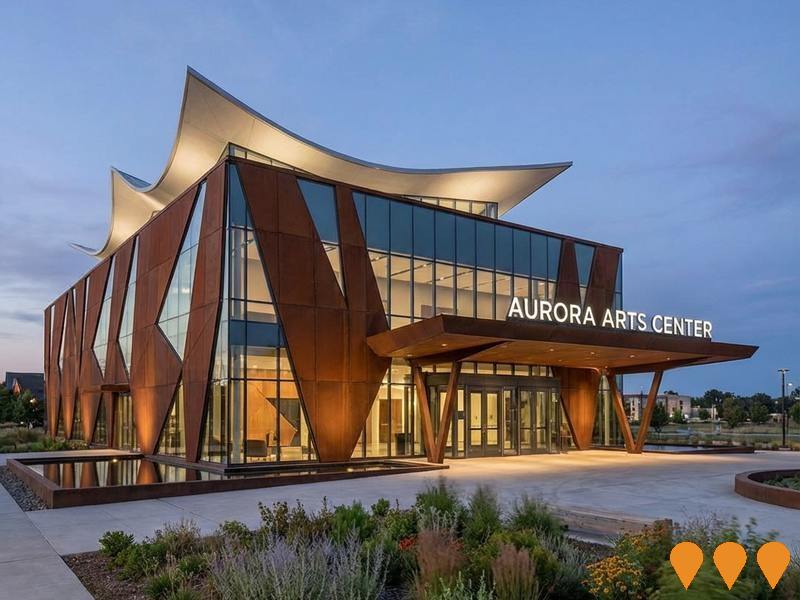Chart Color Schemes
est. as @ -- *
ABS ERP | -- people | --
2021 Census | -- people
Sales Activity
Curious about local property values? Filter the chart to assess the volume and appreciation (including resales) trends and regional comparisons, or scroll to the map below view this information at an individual property level.
Find a Recent Sale
Sales Detail
Population
Hawker is positioned among the lower quartile of areas assessed nationally for population growth based on AreaSearch's assessment of recent, and medium term trends
Hawker's population was around 2,987 as of Aug 2025. This reflected a decrease of 21 people since the 2021 Census which reported a population of 3,008 people. The change was inferred from the estimated resident population of 2,987 from the ABS as of June 2024 and address validation since the Census date. This level of population equated to a density ratio of 1,524 persons per square kilometer, above the average seen across national locations assessed by AreaSearch. Population growth was primarily driven by overseas migration contributing approximately 84.5% of overall population gains during recent periods.
AreaSearch adopted ABS/Geoscience Australia projections for each SA2 area as released in 2024 with 2022 as the base year. For any SA2 areas not covered by this data, and for years post-2032, age group growth rates from the ACT Government's SA2 area projections were adopted with 2022 as a base. Projections indicated an overall population decline over this period, with the area's population expected to shrink by 231 persons by 2041 according to this methodology. However, growth across specific age cohorts was anticipated, led by the 85 and over age group which was projected to grow by 25 people.
Frequently Asked Questions - Population
Development
The level of residential development activity in Hawker is very low in comparison to the average area assessed nationally by AreaSearch
Hawker has recorded approximately three residential properties granted approval each year over the past five financial years, totalling 17 homes. No approvals have been recorded so far in FY-26. Over these five years, an average of 0.7 new residents arrived per new home. The average value for developing new dwellings was $467,000, indicating a focus on the premium segment.
This financial year has seen $919,000 in commercial approvals, reflecting Hawker's residential nature. Compared to the Australian Capital Territory, Hawker records significantly lower building activity, 80.0% below the regional average per person. This limited new supply supports stronger demand and values for established properties. Building activity consists entirely of standalone homes, preserving Hawker's suburban nature with an emphasis on detached housing attracting space-seeking buyers. Developers are constructing more detached housing than the existing pattern implies, reflecting persistent strong demand for family homes.
With around 1985 people per dwelling approval, Hawker reflects a highly mature market. Population is expected to remain stable or decline, potentially reducing pressure on housing and creating opportunities for buyers.
Frequently Asked Questions - Development
Infrastructure
Hawker has emerging levels of nearby infrastructure activity, ranking in the 25thth percentile nationally
No changes can significantly impact an area's performance more than alterations to local infrastructure, major projects, and planning initiatives. AreaSearch has identified a total of 0 projects that are likely to affect the area. Notable projects include Belconnen Town Centre East Precinct (Republic Phase 2 & Future), New Northside Hospital, Ginninderry Estate - Stages 4-7 (Strathnairn & future Macnamara), and Parkwood Urban Release. The following list details those considered most relevant.
Professional plan users can use the search below to filter and access additional projects.
INFRASTRUCTURE SEARCH
 Denotes AI-based impression for illustrative purposes only, not to be taken as definitive under any circumstances. Please follow links and conduct other investigations from the project's source for actual imagery. Developers and project owners wishing us to use original imagery please Contact Us and we will do so.
Denotes AI-based impression for illustrative purposes only, not to be taken as definitive under any circumstances. Please follow links and conduct other investigations from the project's source for actual imagery. Developers and project owners wishing us to use original imagery please Contact Us and we will do so.
Frequently Asked Questions - Infrastructure
Low and Mid-Rise Housing Policy
State-wide NSW planning reforms via amendments to the State Environmental Planning Policy to enable more diverse low and mid-rise housing (dual occupancies, terraces, townhouses, manor houses and residential flat buildings up to 6 storeys) in well-located areas within 800 m of selected train, metro and light-rail stations and town centres. Stage 1 (dual occupancies in R2 zones statewide) commenced 1 July 2024. Stage 2 (mid-rise apartments, terraces and dual occupancies near stations) commenced 28 February 2025. Expected to facilitate up to 112,000 additional homes over the next five years.
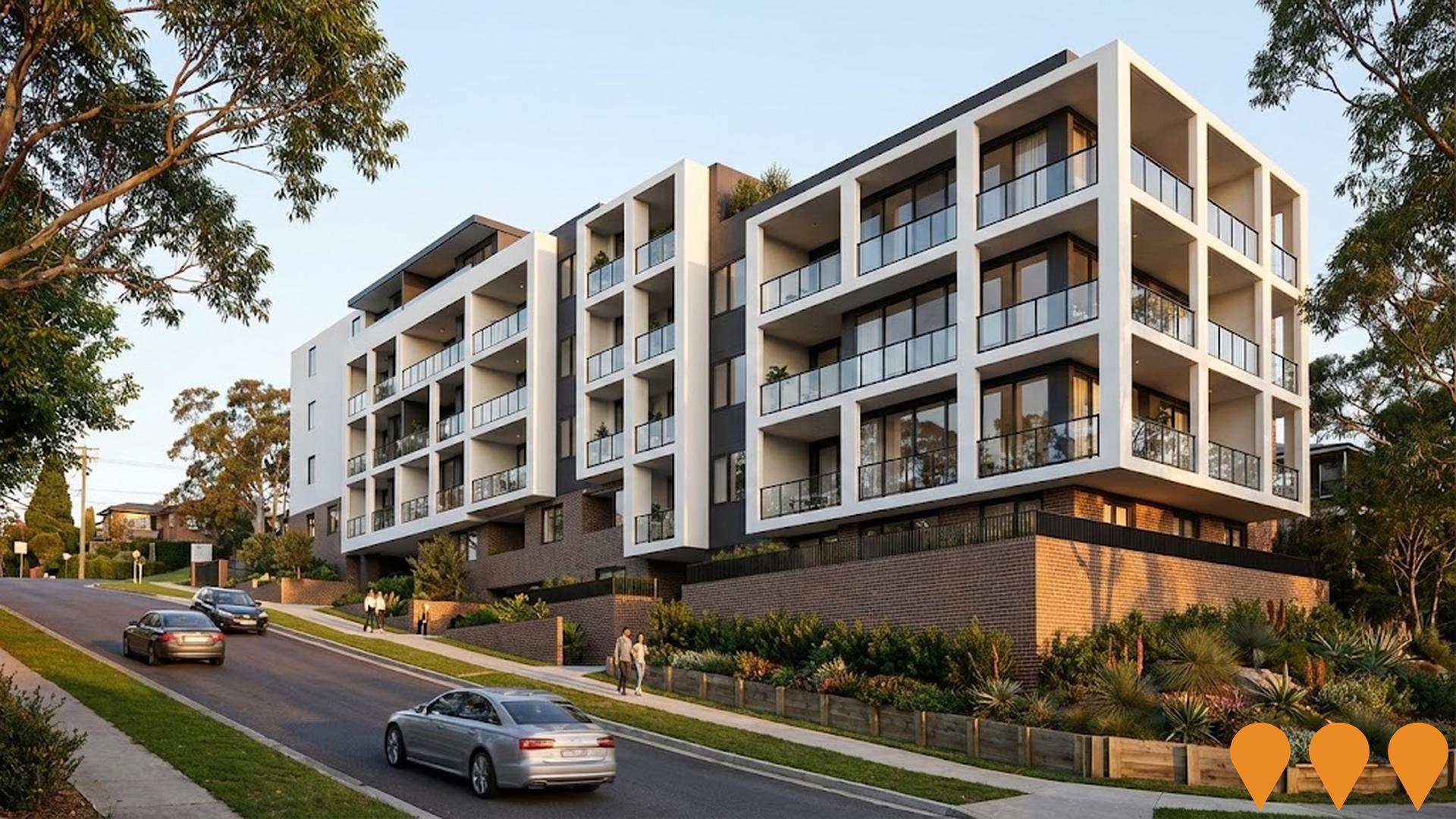
Ginninderry Estate - Stages 4-7 (Strathnairn & future Macnamara)
Canberra's largest master-planned community spanning the ACT-NSW border, delivering approximately 11,500 dwellings total, with ongoing stages immediately adjacent to and west of Dunlop.
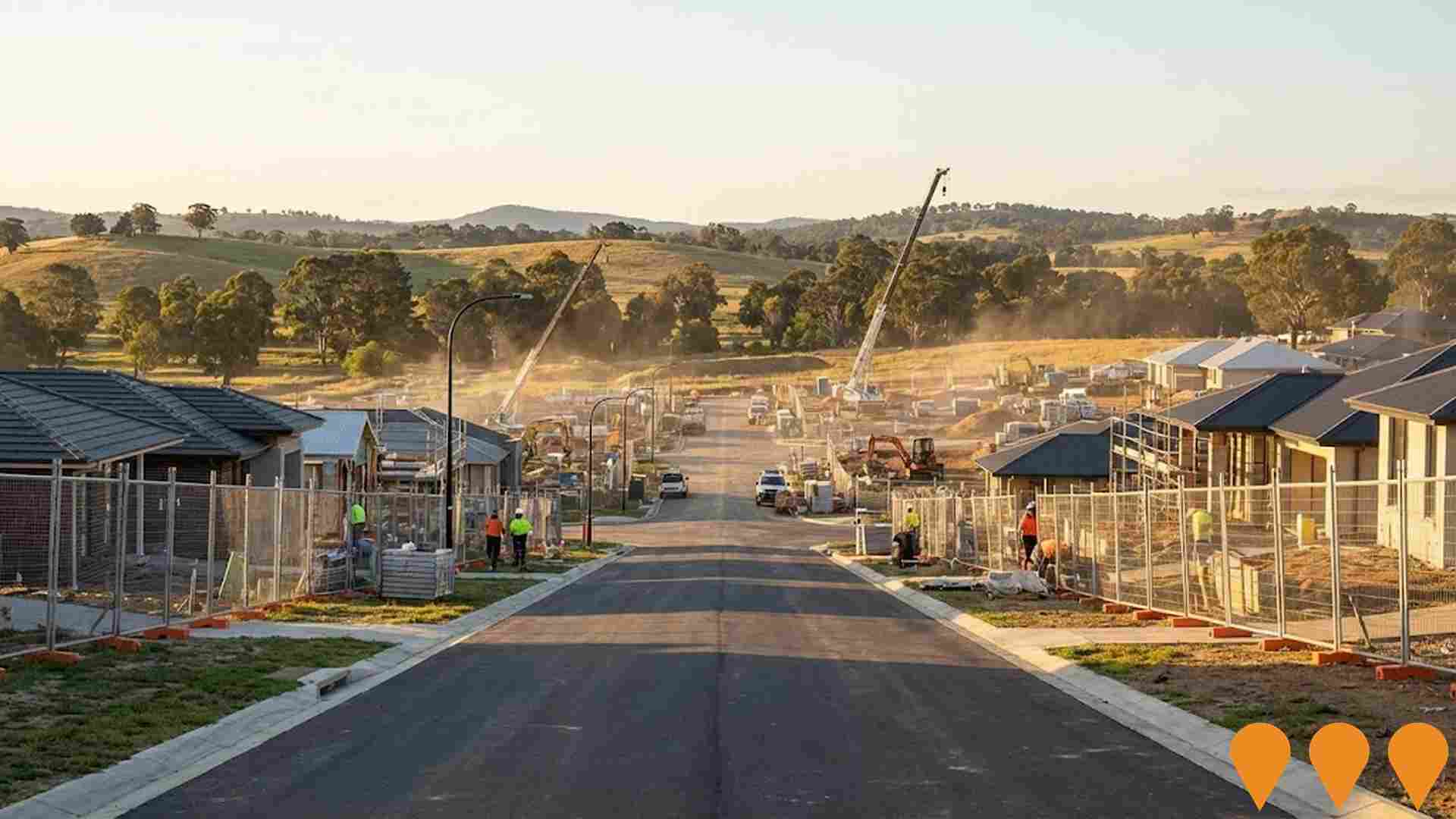
Belconnen Town Centre East Precinct (Republic Phase 2 & Future)
Major mixed-use redevelopment of the former Belconnen Bowling Club site and surrounding land in Belconnen Town Centre (approx. 5 km from Dunlop), delivering apartments, retail, and public spaces.
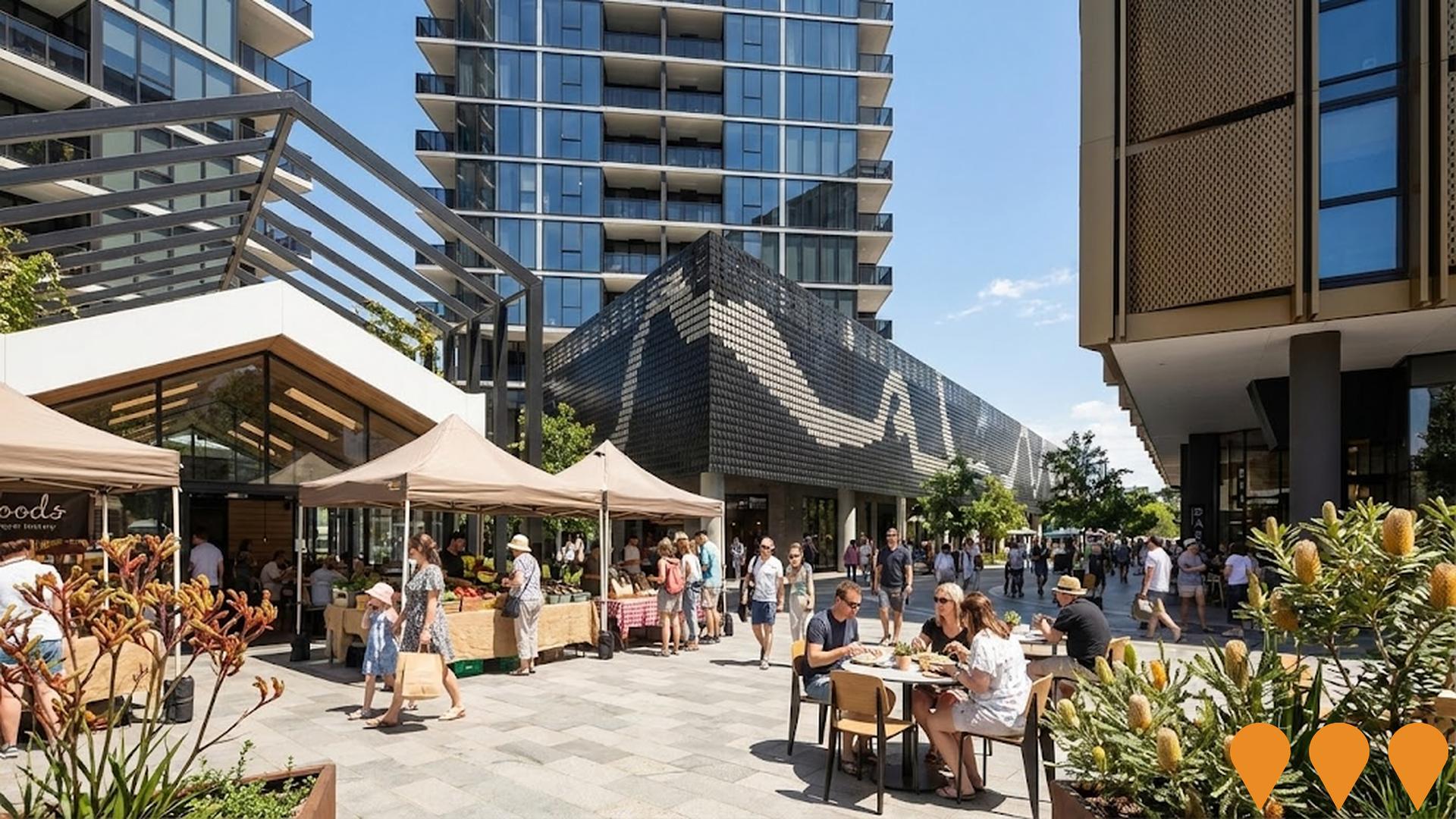
Enhanced bus and light rail corridors (Belconnen & Queanbeyan to Central Canberra)
ACT is progressing an integrated program to enhance high-frequency bus and future light rail corridors that link Belconnen and Queanbeyan with central Canberra. Light Rail Stage 2A (City to Commonwealth Park) commenced construction in early 2025 with services targeted from 2028, while planning and approvals continue for Stage 2B to Woden. The ACT Government has acknowledged and is planning upgrades for the Belconnen-to-City bus corridor as groundwork for a future east-west light rail Stage 3, and is coordinating cross-border public transport initiatives with NSW through the Queanbeyan Region Integrated Transport Plan and the ACT-NSW MoU for Regional Collaboration.
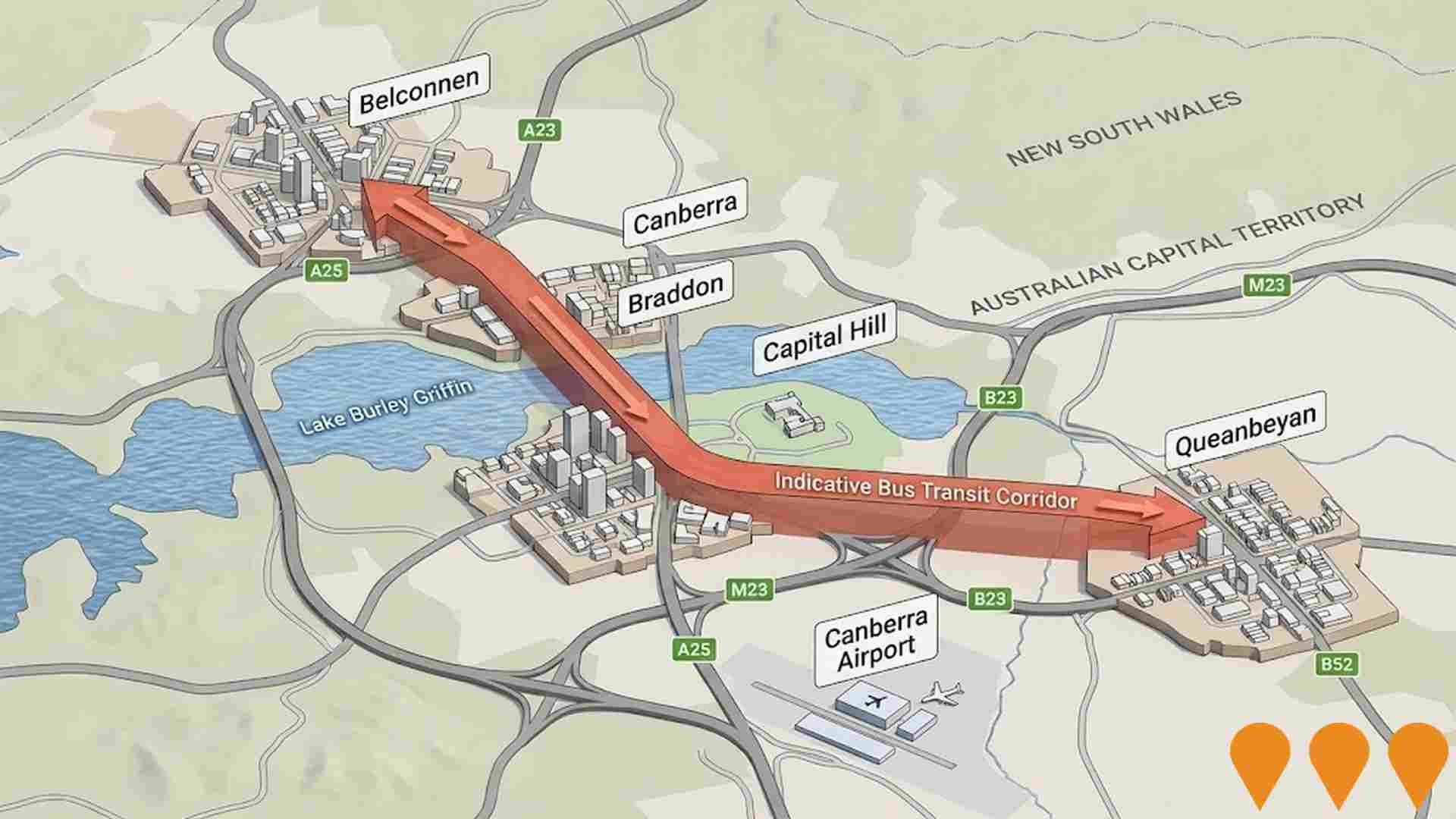
HumeLink
HumeLink is a new 500kV transmission line project connecting Wagga Wagga, Bannaby, and Maragle, spanning approximately 365 km. It includes new or upgraded infrastructure at four locations and aims to enhance the reliability and sustainability of the national electricity grid by increasing the integration of renewable energy sources such as wind and solar.
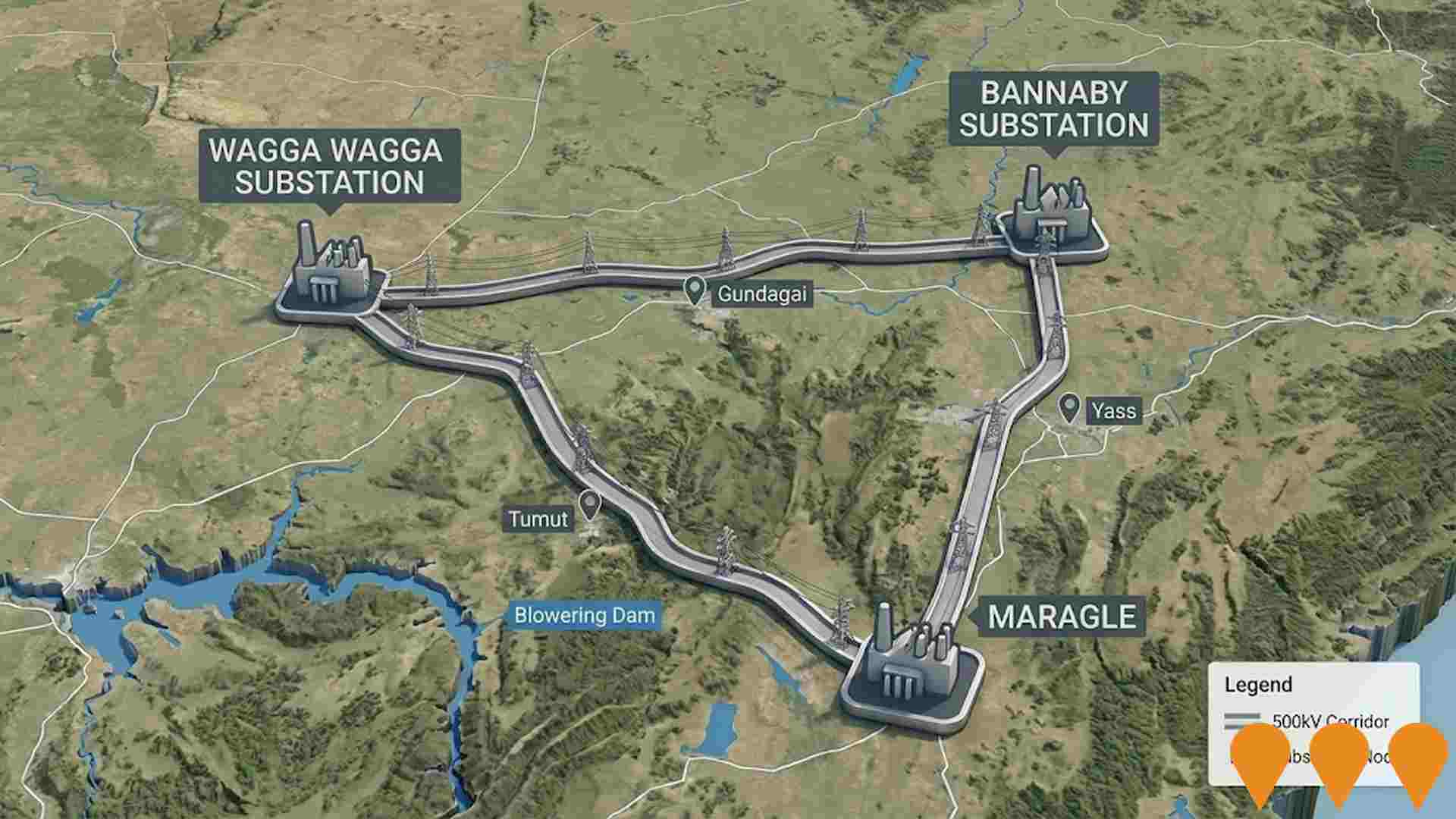
Queanbeyan Regional Integrated Transport Plan
Comprehensive transport planning initiative with 64 key actions for next 10 years. Addresses road safety, active transport connectivity, public transport availability, and future transport needs. Improved connections between Queanbeyan and ACT.
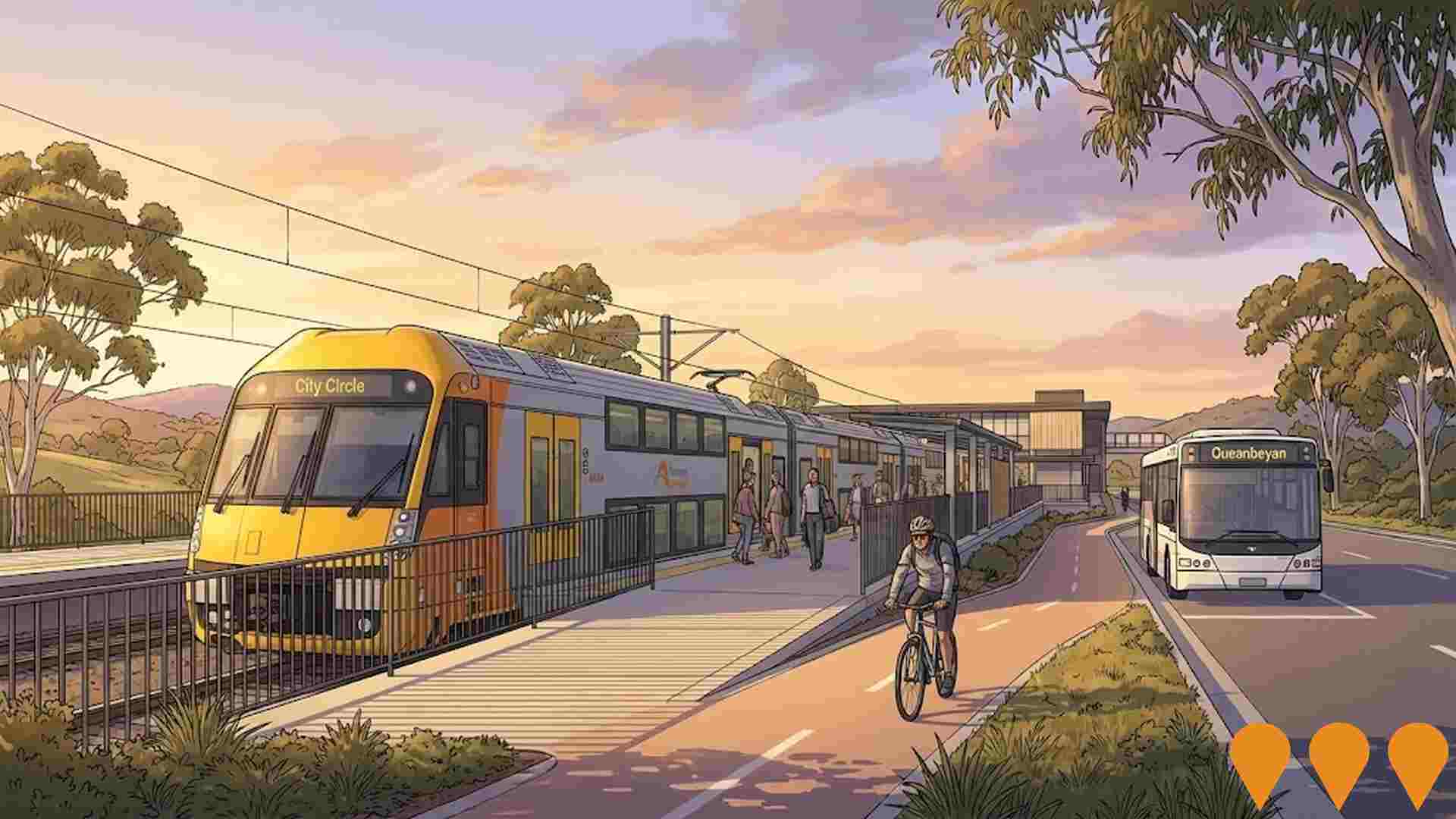
Big Canberra Battery (Williamsdale BESS)
A 250 MW / 500 MWh battery energy storage system at Williamsdale in southern Canberra, delivered by Eku Energy as Stream 1 of the ACT Government's Big Canberra Battery. Construction commenced in November 2024 with partners CPP and Tesla supplying Megapack systems. The asset will connect to Evoenergy's 132 kV network near the Williamsdale substation to provide two hours of dispatchable power, grid services and reliability for the ACT. Target operations in 2026.
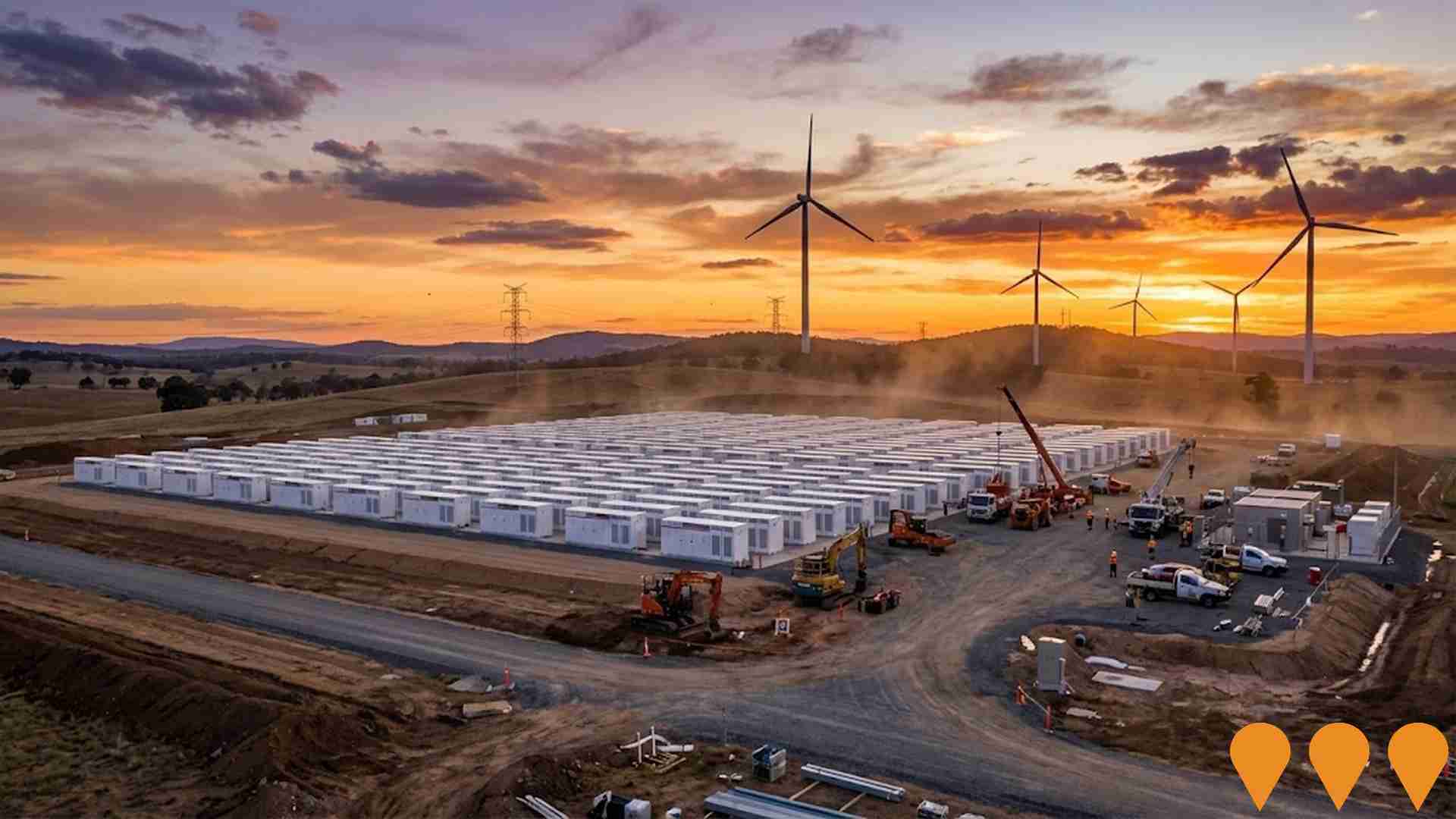
NSW Heavy Vehicle Rest Stops Program (TfNSW)
Statewide Transport for NSW program to increase and upgrade heavy vehicle rest stopping across NSW. Works include minor upgrades under the $11.9m Heavy Vehicle Rest Stop Minor Works Program (e.g. new green reflector sites and amenity/signage improvements), early works on new and upgraded formal rest areas in regional NSW, and planning and site confirmation for a major new dedicated rest area in Western Sydney. The program aims to reduce fatigue, improve safety and productivity on key freight routes, and respond to industry feedback collected since 2022.
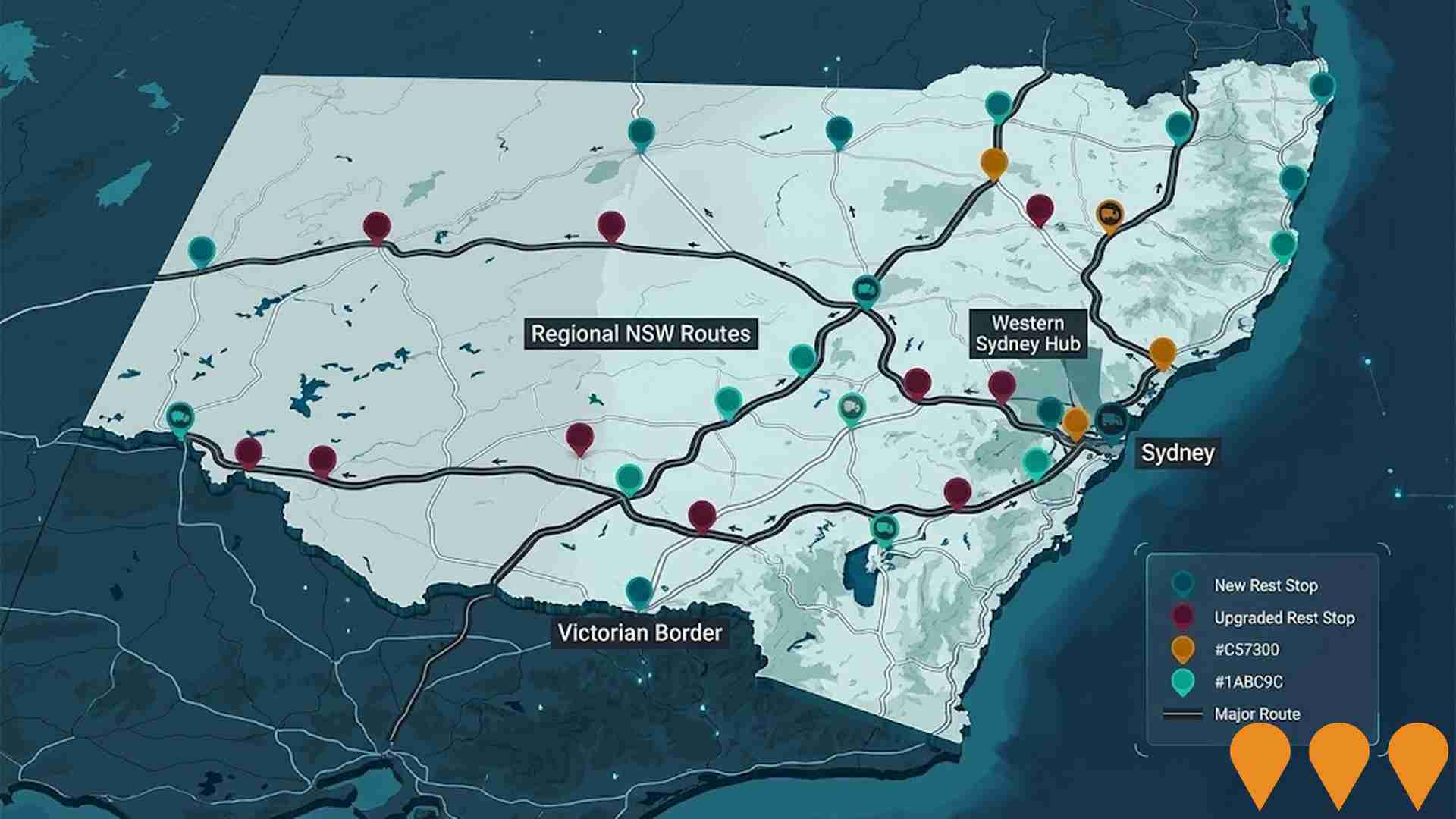
Employment
Employment performance in Hawker exceeds national averages across key labour market indicators
Hawker's workforce is highly educated with strong representation in essential services sectors. The unemployment rate was 2.9% as of June 2025, lower than the Australian Capital Territory's (ACT) rate of 3.4%.
Employment growth over the past year was estimated at 2.4%. As of June 2025, 1,580 residents were employed with an unemployment rate of 0.5% below ACT's rate. Workforce participation in Hawker was 61.5%, compared to ACT's 69.6%. Employment is concentrated in public administration & safety, education & training, and health care & social assistance.
Education & training has a particularly high employment share at 1.4 times the regional level, while public administration & safety is under-represented at 26.2% compared to ACT's 30.4%. Limited local employment opportunities are indicated by the Census working population vs resident population count. Between June 2024 and June 2025, employment levels increased by 2.4%, labour force increased by 1.6%, and unemployment fell by 0.7 percentage points. In comparison, ACT recorded employment growth of 1.9% with a 0.3 percentage point decrease in unemployment. Jobs and Skills Australia's national employment forecasts from May 2025 suggest Hawker's employment could grow approximately 6.6% over five years and 13.5% over ten years, based on simple weighting extrapolation of industry-specific projections against Hawker's employment mix.
Frequently Asked Questions - Employment
Income
Income metrics indicate excellent economic conditions, with the area achieving higher performance than 75% of national locations assessed by AreaSearch
AreaSearch's aggregation of ATO data for financial year 2022 shows Hawker had a median income among taxpayers of $65,318 and an average level of $81,969. These figures are among the highest in Australia, compared to ACT levels of $68,678 and $83,634 respectively. With a 13.6% growth in wages since financial year 2022, current estimates would be approximately $74,201 (median) and $93,117 (average) as of September 2025. Census 2021 income data ranks Hawker's household, family, and personal incomes highly, between the 81st and 90th percentiles nationally. Income distribution shows 32.6% of Hawker residents earning $1,500 - $2,999 weekly, reflecting regional patterns where 34.3% fall within this range. Higher earners are prominent with 35.4% exceeding $3,000 weekly. After housing costs, residents retain 89.7% of income, indicating strong purchasing power and the area's SEIFA income ranking places it in the 8th decile.
Frequently Asked Questions - Income
Housing
Hawker displays a diverse mix of dwelling types, with above-average rates of outright home ownership
Hawker's dwelling structure, as per the latest Census, comprised 67.3% houses and 32.7% other dwellings. In comparison, Australian Capital Territory had 69.4% houses and 30.5% other dwellings. Home ownership in Hawker was at 45.3%, with mortgaged dwellings at 31.4% and rented ones at 23.2%. The median monthly mortgage repayment in Hawker was $2,000, aligning with the Australian Capital Territory average. The median weekly rent in Hawker was $375, compared to Australian Capital Territory's $430. Nationally, Hawker's mortgage repayments were higher than the Australian average of $1,863, while rents were comparable at $375.
Frequently Asked Questions - Housing
Household Composition
Hawker has a typical household mix, with a fairly typical median household size
Family households account for 70.2% of all households, including 30.9% couples with children, 28.8% couples without children, and 9.7% single parent families. Non-family households make up the remaining 29.8%, with lone person households at 26.2% and group households comprising 3.3% of the total. The median household size is 2.5 people, which matches the Australian Capital Territory average.
Frequently Asked Questions - Households
Local Schools & Education
Hawker shows strong educational performance, ranking in the upper quartile nationally when assessed across multiple qualification and achievement indicators
Hawker's educational attainment is notably higher than broader benchmarks. Among residents aged 15+, 52.1% have university qualifications, compared to 30.4% in Australia and 43.8% in the SA3 area. Bachelor degrees are the most common at 29.4%, followed by postgraduate qualifications (16.4%) and graduate diplomas (6.3%). Vocational pathways account for 20.8% of qualifications, with advanced diplomas at 9.6% and certificates at 11.2%.
Educational participation is high, with 29.8% of residents currently enrolled in formal education. This includes 8.6% in secondary education, 8.4% in primary education, and 7.3% pursuing tertiary education. Hawker's three schools have a combined enrollment of 1,556 students. The area has above-average socio-educational conditions (ICSEA: 1094). Educational provision follows conventional lines, with one primary school and two secondary institutions. Hawker functions as an education hub, with 52.1 school places per 100 residents, significantly higher than the regional average of 15.1. This attracts students from surrounding communities.
Frequently Asked Questions - Education
Schools Detail
Nearby Services & Amenities
Transport
Transport servicing is moderate compared to other areas nationally based on assessment of service frequency, route connectivity and accessibility
The analysis of public transport in Hawker shows that there are 26 active transport stops currently operating. These stops serve a mix of bus routes, with a total of 5 individual routes providing service to the area. The combined weekly passenger trips across these routes amount to 366.
The accessibility of transport in Hawker is rated as excellent, with residents on average located just 157 meters from their nearest transport stop. On average, there are 52 trips per day across all routes, which equates to approximately 14 weekly trips per individual stop.
Frequently Asked Questions - Transport
Transport Stops Detail
Health
Health performance in Hawker is lower than average with common health conditions somewhat prevalent across both younger and older age cohorts
Hawker faces significant health challenges, with common health conditions prevalent among both younger and older age cohorts. Approximately 61% of Hawker's total population (1,816 people) have private health cover, compared to 57.1% in the Australian Capital Territory and a national average of 55.3%. The most common medical conditions are arthritis and mental health issues, affecting 9.1% and 8.4% of residents respectively.
65.8% of residents declare themselves completely clear of medical ailments, compared to 68.1% in the Australian Capital Territory. Hawker has a higher proportion of residents aged 65 and over at 21.2%, with 633 people falling into this age group, compared to 15.3% in the Australian Capital Territory.
Frequently Asked Questions - Health
Cultural Diversity
Hawker was found to be more culturally diverse than the vast majority of local markets in Australia, upon assessment of a range of language and cultural background related metrics
Hawker's population was found to be more culturally diverse than most local markets, with 26.4% born overseas and 18.8% speaking a language other than English at home. Christianity was the predominant religion in Hawker, accounting for 39.2% of its population. Hinduism was notably overrepresented, comprising 3.7%, compared to 4.0% across Australian Capital Territory.
The top three ancestry groups were English (25.9%), Australian (23.4%), and Other (11.3%). Notably, Welsh (1.0%) and Hungarian (0.5%) ethnicities were overrepresented in Hawker compared to regional averages of 0.6% and 0.3%, respectively. Scottish ethnicity was also relatively high at 9.3%.
Frequently Asked Questions - Diversity
Age
Hawker hosts an older demographic, ranking in the top quartile nationwide
Hawker has a median age of 42, which is higher than the Australian Capital Territory figure of 35 years. This is also significantly higher than Australia's median age of 38 years. Compared to the Australian Capital Territory average, Hawker has an over-representation of the 75-84 age cohort (9.1%), while the 25-34 age group is under-represented (12.4%). Between 2021 and present, the proportion of the population aged 15 to 24 has increased from 12.4% to 14.2%. Conversely, the proportion of those aged 65 to 74 has decreased from 11.2% to 9.2%. By 2041, demographic modeling suggests Hawker's age profile will change significantly. The number of people aged 85 and above is projected to increase by 23 (a rise of 28%) to reach 109. Notably, the combined age groups of 65+ are expected to account for 82% of total population growth. This reflects Hawker's aging demographic profile. Meanwhile, the 65 to 74 and 0 to 4 age cohorts are projected to experience population declines.


